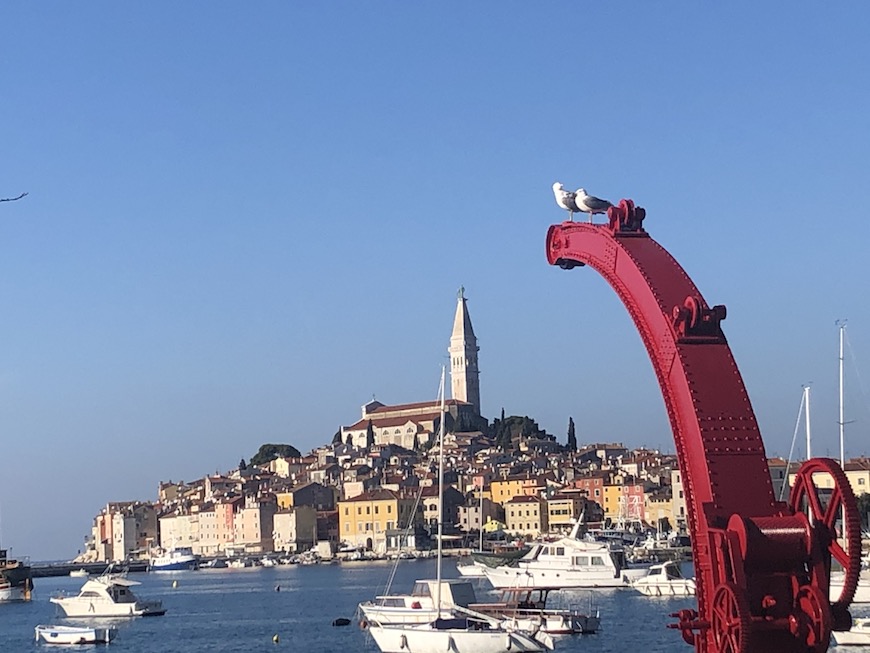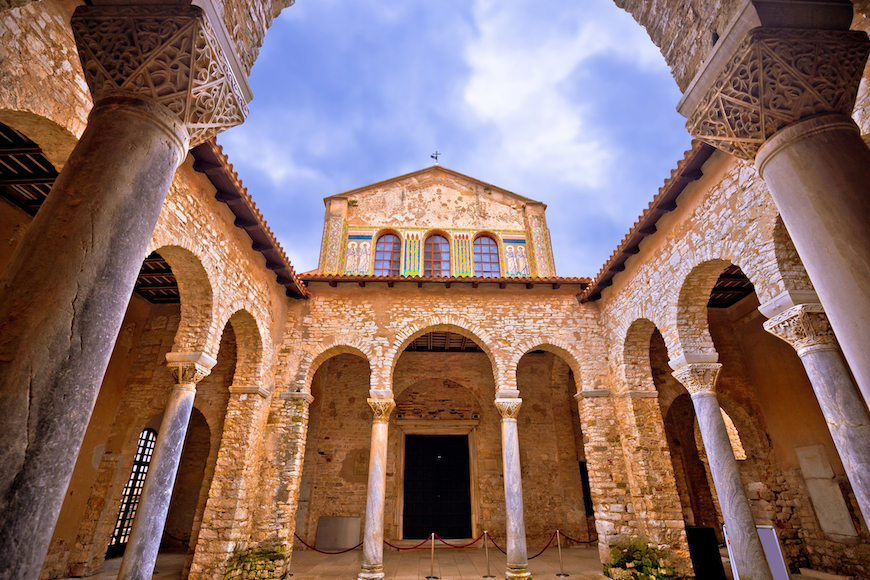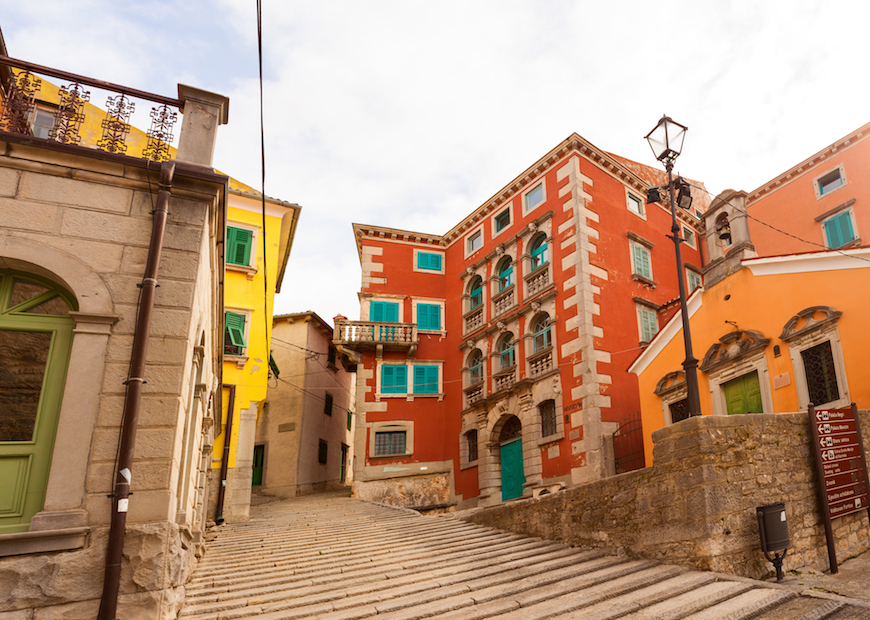Istria towns and sights not to be missed
Istria towns and sights are made for postcards. Add the beauty and wonder of Istria to your upcoming itinerary and you’ll be sure to have plenty to write home about:
ROVINJ
This former fisherman village became one of the most popular destinations in Croatia and definitely one of Istria towns and sights not to be missed. The Old town, situated on the peninsula, is characteristic for houses that are closely built, narrow streets and small squares, still untouched by modern urbanism.
Surrounded by its 22 islands is an area of protected natural heritage. The Old town was also originally an island, previously connected to the mainland in 1763 until the narrow channel separating it was filled.
The main Church of St. Euphemia keeps relics of the saint and presents one of the most beautiful Baroque achievements in Istria. From the church plateau, there is a wonderful view of the open sea and numerous islets in the distance, so it is definitely worth the walk there; explore narrow medieval streets along the way. Other sites not to be missed include:
- The core of the Communal or Town Palace, the site of present-day town administration, which dates from the 16th century. Apart from being the Praetorian Palace in the past, it also served as a prison.
- If you wish to explore beyond the Old town, visit Monkodonja – a Bronze Age settlement near Rovinj located on an elevation. The settlement was surrounded by triple walls built in the dry wall technique. It represents the most comprehensive exploration of a Bronze Age settlement in this part of Europe since 1997.
- The Palud Bay, located 8 km south-west of Rovinj, is the only ornithological park in Istria. Water from neighboring hills and valleys as well as northern side springs turned this natural depression located in the vicinity of the sea into a swamp.
PULA
Did you know that famous writer James Joyce lived with his wife in Pula at the beginning of the 20th century and taught the English language in the building at the Portarata square? In his honor, there is a sculpture near the coffee bar Uliks that carries the novelist’s name (Croatian for Ulysses). Visitors can have their favorite drink with Joyce and take a selfie with him at one of the most beautiful squares in Pula.
The history of this town starts with the myth of the Argonauts and the search for the Golden Fleece. It was the home of the Histrians, the Romans and the Venetians. Once the central Austrian port, today is the largest cultural and economic center of Istria.
This largest town on the Istrian peninsula offers a diversity of attractions to culture lovers. The rich itinerary of its 3,000-year-old history, where every step you take through the old town is a landmark, begins and ends with the Roman Amphitheater, thus on the list of Istria towns and sights not to be missed.
This is one of the best preserved Roman amphitheaters in the world, the most significant monument in Pula! Arena – the place where gladiators faced lions and used to entertain 25,000 spectators. This grandiose edifice gives insight to its glorious history - the one you can see, feel, and experience. It also serves as a host to the greatest cultural programs. Below the fighting ground of the Pula Arena was the spare underground room used for keeping beasts in their cages, while today it is the site of the permanent exhibition titled ‘Olive and Wine Production of Istria during the Antique Period’. Pula’s sights not to be missed:
- Pula market built in the 19th century is a true construction miracle and one of the most beautiful examples of the Secession. The market is located in the center of Pula. The building of the indoor part of the market began in 1902, and it was officially opened on October 18, 1903. Modern materials such as iron and glass were used for the first time in its construction.
- The Triumphal Arch of the Sergi, best known as the Golden Gate, was erected by the Sergi family, a powerful Roman family which had maintained its power and glory through centuries. It was named Porta Aurea or the Golden Gate due to its lavish decorative arch or the gild on the town gate supporting the town walls as well as the triumphal arch at that time.
- The Forum is a central square of ancient and medieval Pula, located in the western part of the town. It was built during the 1st century BC on the designated area, with the entire city administration. It followed suit of any other Roman forum housing the temple dedicated to the Capitoline triad of Jupiter, Juno and Minerva. Apart from the central, there were two side temples on the Pula Forum. The Temple of Augustus is the only one fully preserved, while only the back wall of the other one is visible.
- Below Pula is an underground tunnel world, stretching almost across the entire Pula, known as Zerostrasse. Pula’s underground tunnels were erected during WW1 to provide a shelter for people in case of air raids. One part of the tunnel is used today for holding various cultural and social events, from exhibitions to parties.
- The new Istrian Lighting Giants have taken on modern shapes, transforming the cranes of Uljanik Shipyard, a symbol of the town of Pula, into color-lit colossuses. Eight huge cranes, located in the center of the town, are ablaze in thousands of colors. With the help of flood-lights, these colors change and special effects are created that light up Pula’s night sky. This magnificent light show, lasting 15 minutes, can be seen after dark on the hour!
- Nesactium was the seat of the Histri, the Iron Age people who inhabited Istria. Numerous archaeological findings show its permanent population, from the prehistoric era until the Late Antiquity. The archaeological site Nesactium is located on the Glavica hill near Valtura, east of Pula, above a fertile valley and the Budava Bay.
POREČ
In this former Roman colony you can enjoy the sights of Romanesque architecture with beautiful Venetian gothic palaces that will make your walk a truly memorable experience. Poreč or Parentium in Antiquity, has preserved its ancient street layout with the former main Roman street of Decumanus Maximus as the lifeline of the town of Decumanus. Poreč is for sure one of Istria towns and sights not to be missed!
- Euphrasian Basilica is a breathtaking sight beyond a doubt, and the most important site in Poreč. It was built in the middle of the 6th century in the Byzantine style, and the mosaics on its front and interior are truly one of the most beautiful works of art in the world! The whole edifice has been included in the UNESCO’s World Heritage list. Its biggest treasure are magnificent mosaics on the apse headpiece.
- The Temple of Neptune was erected on the Poreč forum in the 1st century. It is thought to be the biggest in Istria, although only a portion of its walls and the foundations have been preserved. Enjoy exploring the peninsula and its Baroque and Renaissance buildings, museums and galleries.
LABIN & RABAC
With only 5 kilometers distance between, Labin & Rabac are definitely two of the Istria towns and sights not to be missed! Labin is the heritage highlight of eastern Istria, as well as its administrative center, situated only three kilometers from the sea. Today it is a town known for its numerous galleries and artists. The most fascinating sight is the central town square with the perfectly preserved loggia and main town gate of St. Flora from the 16th century. Taking a walk through the Mediterranean and European history, your attention will be drawn by the Municipal Loggia and numerous palaces, medieval fortifications with Renaissance bastion, and the 17th century church tower, the highest point from which one can see Rabac and Kvarner bay.
- Rabac, once a small fishing place, is today a beautiful tourist destination. Should you choose to go further from the coast, you will find peace and quiet in the intact nature. You can take the hiking path, Labin hiking trail or the mountain-bike trails. Make sure to enjoy the beautiful trail connecting Labin with sea side Rabac. The trail has numerous brooks and rapids, crossed by seven bridges creating an elvish experience.
The biggest attractions are the several meter high waterfalls which flow over the winding limestone barriers. Near the biggest one, there used to be an old mill, which remains are still visible. There, it joins the magnificent turquoise lake. The mystery of the Negri Cave, with interior hiding the clear water spring, also attracts attention. The legend says that a skeleton of a giant three times the size of a human was found in the cave. Despite the attempts to find it, the Giant of Labin has remained nothing more than a legend.







Pingback: Istria towns and sights not to be missed, the beauty made for postcards – Travel News